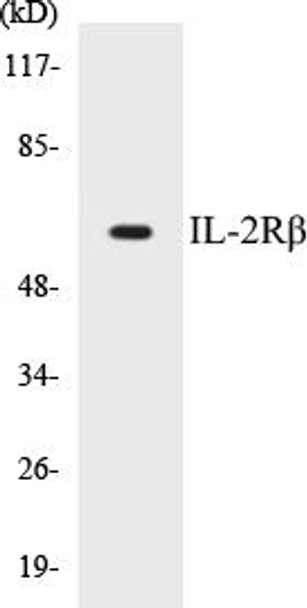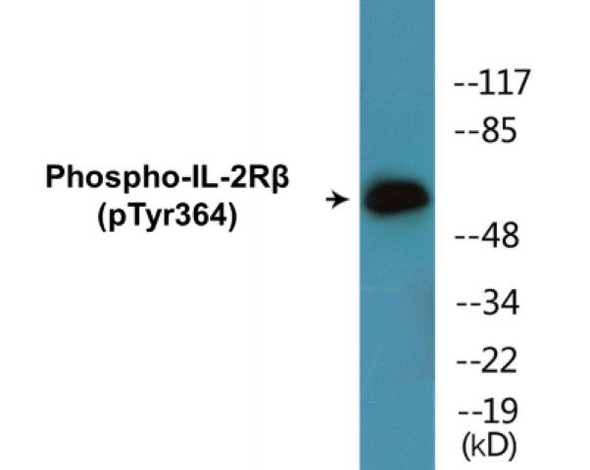Description
IL-2Rbeta Colorimetric Cell-Based ELISA Kit
The IL-2Rbeta Colorimetric Cell-Based ELISA Kit is specifically designed for the quantitative measurement of IL-2Rbeta levels in cell culture samples. This kit provides researchers with a highly sensitive and specific assay that delivers reliable and reproducible results, making it an excellent tool for a variety of research applications.IL-2Rbeta, also known as interleukin-2 receptor subunit beta, is a key protein involved in the immune response and plays a crucial role in T cell activation and proliferation. Dysregulation of IL-2Rbeta has been implicated in various autoimmune disorders, inflammatory diseases, and cancer.
Therefore, accurate measurement of IL-2Rbeta levels is essential for studying these conditions and developing targeted therapies.With the IL-2Rbeta Colorimetric Cell-Based ELISA Kit, researchers can confidently detect and quantify IL-2Rbeta levels in cell culture supernatants, providing valuable insights into the role of this protein in health and disease. This kit is easy to use, highly sensitive, and offers excellent specificity, making it a valuable asset for any laboratory conducting research on immune responses and related diseases.
| Product Name: | IL-2Rbeta Colorimetric Cell-Based ELISA |
| Product Code: | CBCAB00713 |
| ELISA Type: | Cell-Based |
| Target: | IL-2Rbeta |
| Reactivity: | Human, Mouse, Rat |
| Dynamic Range: | > 5000 Cells |
| Detection Method: | Colorimetric 450 nmStorage/Stability:4°C/6 Months |
| Format: | 96-Well Microplate |
The IL-2Rbeta Colorimetric Cell-Based ELISA Kit is a convenient, lysate-free, high throughput and sensitive assay kit that can detect IL-2Rbeta protein expression profile in cells. The kit can be used for measuring the relative amounts of IL-2Rbeta in cultured cells as well as screening for the effects that various treatments, inhibitors (ie siRNA or chemicals), or activators have on IL-2Rbeta.
Qualitative determination of IL-2Rbeta concentration is achieved by an indirect ELISA format. In essence, IL-2Rbeta is captured by IL-2Rbeta-specific primary antibodies while the HRP-conjugated secondary antibodies bind the Fc region of the primary antibody. Through this binding, the HRP enzyme conjugated to the secondary antibody can catalyze a colorimetric reaction upon substrate addition. Due to the qualitative nature of the Cell-Based ELISA, multiple normalization methods are needed:
| 1. | A monoclonal antibody specific for human GAPDH is included to serve as an internal positive control in normalizing the target absorbance values. |
| 2. | Following the colorimetric measurement of HRP activity via substrate addition, the Crystal Violet whole-cell staining method may be used to determine cell density. After staining, the results can be analysed by normalizing the absorbance values to cell amounts, by which the plating difference can be adjusted. |
| Database Information: | Gene ID: 3560, UniProt ID: P14784, OMIM: 146710, Unigene: Hs.474787 |
| Gene Symbol: | IL2RB |
| Sub Type: | None |
| UniProt Protein Function: | IL2RB: Receptor for interleukin-2. This beta subunit is involved in receptor mediated endocytosis and transduces the mitogenic signals of IL2. Non-covalent dimer of an alpha and a beta subunit. IL2R exists in 3 different forms: a high affinity dimer, an intermediate affinity monomer (beta subunit), and a low affinity monomer (alpha subunit). The high and intermediate affinity forms also associate with a gamma subunit. Interacts with SHB upon interleukin stimulation. Interacts with HTLV-1 accessory protein p12I. Belongs to the type I cytokine receptor family. Type 4 subfamily. |
| UniProt Protein Details: | Protein type:Receptor, cytokine; Membrane protein, integral Chromosomal Location of Human Ortholog: 22q13.1 Cellular Component: external side of plasma membrane; integral to plasma membrane; intracellular; membrane; plasma membrane Molecular Function:interleukin-2 binding; interleukin-2 receptor activity; protein binding Biological Process: activation of MAPKK activity; axon guidance; cytokine and chemokine mediated signaling pathway; epidermal growth factor receptor signaling pathway; fibroblast growth factor receptor signaling pathway; innate immune response; insulin receptor signaling pathway; MAPKKK cascade; natural killer cell activation; negative regulation of apoptosis; nerve growth factor receptor signaling pathway; protein complex assembly; Ras protein signal transduction; signal transduction; small GTPase mediated signal transduction; vascular endothelial growth factor receptor signaling pathway; viral reproduction |
| NCBI Summary: | The interleukin 2 receptor, which is involved in T cell-mediated immune responses, is present in 3 forms with respect to ability to bind interleukin 2. The low affinity form is a monomer of the alpha subunit and is not involved in signal transduction. The intermediate affinity form consists of an alpha/beta subunit heterodimer, while the high affinity form consists of an alpha/beta/gamma subunit heterotrimer. Both the intermediate and high affinity forms of the receptor are involved in receptor-mediated endocytosis and transduction of mitogenic signals from interleukin 2. The protein encoded by this gene represents the beta subunit and is a type I membrane protein. [provided by RefSeq, Jul 2008] |
| UniProt Code: | P14784 |
| NCBI GenInfo Identifier: | 124321 |
| NCBI Gene ID: | 3560 |
| NCBI Accession: | P14784.1 |
| UniProt Secondary Accession: | P14784,B2R765, |
| UniProt Related Accession: | P14784 |
| Molecular Weight: | |
| NCBI Full Name: | Interleukin-2 receptor subunit beta |
| NCBI Synonym Full Names: | interleukin 2 receptor subunit beta |
| NCBI Official Symbol: | IL2RB |
| NCBI Official Synonym Symbols: | CD122; IL15RB; P70-75 |
| NCBI Protein Information: | interleukin-2 receptor subunit beta |
| UniProt Protein Name: | Interleukin-2 receptor subunit beta |
| UniProt Synonym Protein Names: | High affinity IL-2 receptor subunit beta; p70-75; p75; CD_antigen: CD122 |
| Protein Family: | Interleukin-2 receptor |
| UniProt Gene Name: | IL2RB |
| UniProt Entry Name: | IL2RB_HUMAN |
| Component | Quantity |
| 96-Well Cell Culture Clear-Bottom Microplate | 2 plates |
| 10X TBS | 24 mL |
| Quenching Buffer | 24 mL |
| Blocking Buffer | 50 mL |
| 15X Wash Buffer | 50 mL |
| Primary Antibody Diluent | 12 mL |
| 100x Anti-Phospho Target Antibody | 60 µL |
| 100x Anti-Target Antibody | 60 µL |
| Anti-GAPDH Antibody | 60 µL |
| HRP-Conjugated Anti-Rabbit IgG Antibody | 12 mL |
| HRP-Conjugated Anti-Mouse IgG Antibody | 12 mL |
| SDS Solution | 12 mL |
| Stop Solution | 24 mL |
| Ready-to-Use Substrate | 12 mL |
| Crystal Violet Solution | 12 mL |
| Adhesive Plate Seals | 2 seals |
The following materials and/or equipment are NOT provided in this kit but are necessary to successfully conduct the experiment:
- Microplate reader able to measure absorbance at 450 nm and/or 595 nm for Crystal Violet Cell Staining (Optional)
- Micropipettes with capability of measuring volumes ranging from 1 µL to 1 ml
- 37% formaldehyde (Sigma Cat# F-8775) or formaldehyde from other sources
- Squirt bottle, manifold dispenser, multichannel pipette reservoir or automated microplate washer
- Graph paper or computer software capable of generating or displaying logarithmic functions
- Absorbent papers or vacuum aspirator
- Test tubes or microfuge tubes capable of storing ≥1 ml
- Poly-L-Lysine (Sigma Cat# P4832 for suspension cells)
- Orbital shaker (optional)
- Deionized or sterile water
*Note: Protocols are specific to each batch/lot. For the correct instructions please follow the protocol included in your kit.
| Step | Procedure |
| 1. | Seed 200 µL of 20,000 adherent cells in culture medium in each well of a 96-well plate. The plates included in the kit are sterile and treated for cell culture. For suspension cells and loosely attached cells, coat the plates with 100 µL of 10 µg/ml Poly-L-Lysine (not included) to each well of a 96-well plate for 30 minutes at 37°C prior to adding cells. |
| 2. | Incubate the cells for overnight at 37°C, 5% CO2. |
| 3. | Treat the cells as desired. |
| 4. | Remove the cell culture medium and rinse with 200 µL of 1x TBS, twice. |
| 5. | Fix the cells by incubating with 100 µL of Fixing Solution for 20 minutes at room temperature. The 4% formaldehyde is used for adherent cells and 8% formaldehyde is used for suspension cells and loosely attached cells. |
| 6. | Remove the Fixing Solution and wash the plate 3 times with 200 µL 1x Wash Buffer for five minutes each time with gentle shaking on the orbital shaker. The plate can be stored at 4°C for a week. |
| 7. | Add 100 µL of Quenching Buffer and incubate for 20 minutes at room temperature. |
| 8. | Wash the plate 3 times with 1x Wash Buffer for 5 minutes each time. |
| 9. | Add 200 µL of Blocking Buffer and incubate for 1 hour at room temperature. |
| 10. | Wash 3 times with 200 µL of 1x Wash Buffer for 5 minutes each time. |
| 11. | Add 50 µL of 1x primary antibodies (Anti-IL-2Rbeta Antibody and/or Anti-GAPDH Antibody) to the corresponding wells, cover with Parafilm and incubate for 16 hours (overnight) at 4°C. If the target expression is known to be high, incubate for 2 hours at room temperature. |
| 12. | Wash 3 times with 200 µL of 1x Wash Buffer for 5 minutes each time. |
| 13. | Add 50 µL of 1x secondary antibodies (HRP-Conjugated AntiRabbit IgG Antibody or HRP-Conjugated Anti-Mouse IgG Antibody) to corresponding wells and incubate for 1.5 hours at room temperature. |
| 14. | Wash 3 times with 200 µL of 1x Wash Buffer for 5 minutes each time. |
| 15. | Add 50 µL of Ready-to-Use Substrate to each well and incubate for 30 minutes at room temperature in the dark. |
| 16. | Add 50 µL of Stop Solution to each well and read OD at 450 nm immediately using the microplate reader. |
(Additional Crystal Violet staining may be performed if desired – details of this may be found in the kit technical manual.)






